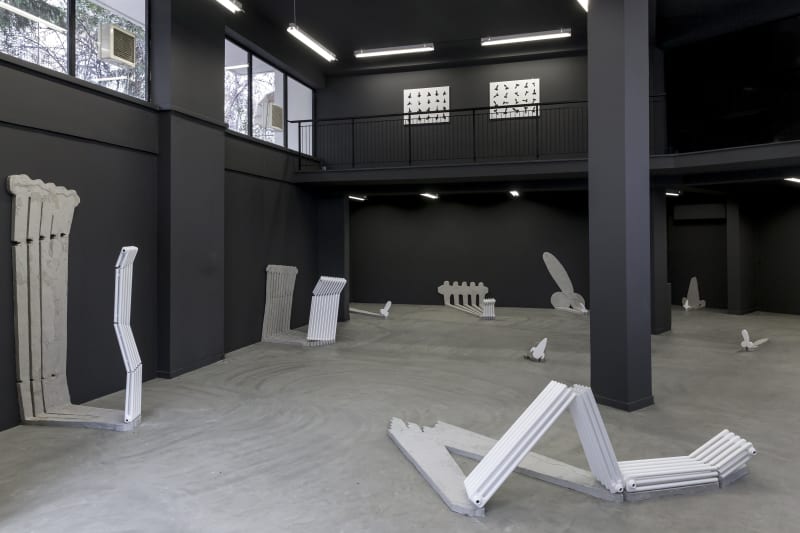Dio Horia is pleased to present Long Shadows, a new series of works by London-based artist Ally Rosenberg. Marking the artist’s first residency and solo exhibition in Greece, Long Shadows opens on March 15th, in the presence of the artist.
The exhibition includes a new series of sculptures by Rosenberg, the entirety of which were created in Athens during his participation in Dio Horia’s residency program.
Long Shadows is a darkly playful exploration of the body, through material, object, image and time. Each of Rosenberg’s sculptural works is seated on a solid, plinth- like shadow, cast in concrete and stretched across the gallery floors and walls. Dissected column radiators - once emitting heat, now rendered cold and redundant - fold, lean, and recline, playing with the traditional modes of sculpture and architecture that contextualise Rosenberg’s time in residency in Athens. These radiators - called ‘Athens radiators’ in the UK, but not actually available in Athens - take a sublime historical aesthetic and reduce it to the pedestrian, middle-class tastes of domestic design. Crude, cartoonish penises and noses are cut from Athenian marble slabs and strewn across the floor, with shadows exaggerating their size. A doodle of a cloud, clad with ceramic bathroom tiles, is scrawled on the wall like adolescent graffiti.
“Where the body and architecture were once elevated to godly status, rendered in materials of permanent strength, with time, colours fade, pieces get broken off and meanings get revised and reappropriated. Columns designed to uphold the weight of grand structures eventually crumble. The bits that break off sculptures over time are the appendages - noses and penises - protrusions that supposedly signify strength and masculinity. Emperors and gods are eventually castrated by the passing millennia. Working in residence in Athens - a place of such deep and significant history - at a time when it feels like we are watching history unfold day by day, has felt strange. The dick-swinging competitions of thousands of years ago certainly cast a long shadow...”
In Long Shadows, Rosenberg uses literal, concrete shadows to describe a relationship between an object and its environment. They fold and wrap around a space, casting illusions, flattening 3D objects into two-dimensions, distorting, stretching and inflating them. Our shadows are evidence of our physical presence; our opaque materiality getting in the way of light. They are an extension of ourselves. They tell us the time, shifting and morphing throughout the day. We use them as symbols of unshakeable legacies, long-standing influences and perhaps things rather forgotten. Their ephemeral, shape-shifting elusiveness encourages us to project onto them, like psychological ink-blot drawings. In them, we are neurologically hardwired to see threats, or simulacra of ourselves. That which resides in a shadow is never fully hidden or revealed - it lurks.

